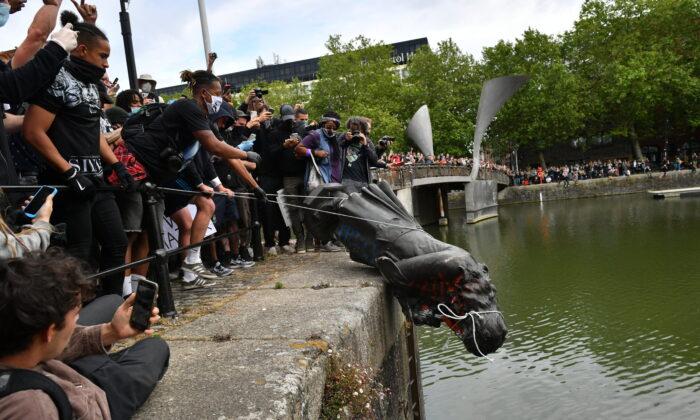The toppling of the Edward Colston statue during a Black Lives Matter protest in 2020 was “violent” and therefore the defendants were not protected by the European Convention on Human Rights (ECHR), the UK’s Court of Appeal ruled on Wednesday.
The ruling does not overturn the acquittal of criminal damage charges against the four defendants.

The trial heard that Ponsford and Graham brought ropes, which Willoughby passed around the statue’s neck, and Skuse goaded the crowd into rolling the statue 500 metres (1,640 feet) and throwing it into the water.
But the defendants claimed that the presence of the slave trader’s statue was a hate crime or an indecent display and that the tearing down of the statue was to prevent a crime.
Defence lawyer Raj Chada said the “defendants should never have been prosecuted.”
‘Outside the Protection’ of the ECHR
During the ruling on Wednesday, the Lord Chief Justice Lord Burnett, sitting with Mr. Justice Holgate and Mr. Justice Saini, said the Crown Prosecution Service (CPS) was right to argue the prosecution of the four was not an abuse of process because the conduct of the protesters “fell outside the protection” of the ECHR.“Although this case did not involve the destruction of the statue, the damage that was caused was clearly significant,” Burnett said.
“Pulling this heavy bronze statue to the ground required it to be climbed, ropes attached to it, and then the use of a good deal of force to bring it crashing to the ground.”
The judge said the circumstances in which the statue was damaged “did not involve peaceful protest.”
“The toppling of the statute was violent. Moreover, the damage to the statue was significant,” he said.
“On both these bases we conclude that the prosecution was correct in its submission at the abuse hearing that the conduct in question fell outside the protection of the Convention.”
He stressed that it does not suggest the four were in fact guilty of criminal damage, because there were other defences deployed by them at their trial and it is “impossible to know” on what basis the jury reached its verdict.
Chada, who represented the four, said, “We are disappointed by the Court of Appeal judgment.”
He said the toppling was “not done violently” and that “the value of the statue had increased exponentially after the toppling.”
Campaign group Save Our Statues wrote on Twitter ahead of the ruling that “nobody has a right to violently damage property because they are ‘offended’, and it’s vital that this principle is clarified in law.”

In the 17th and 18th centuries, Bristol, a key port in the west of England, became one of the main centres of the British Empire’s slave trade. But while many of those involved have been forgotten, Colston’s name lived on because he became a philanthropist.
The page said Colston and his father had shares in the Royal African Company (RAC), in which members traded gold, ivory, and enslaved Africans. He had also been an active member of RAC’s governing body for 11 years.
A separate museum page said Colston “campaigned to keep the slave trade legal and on favourable terms for traders” late in his life when he was a Bristol MP.





